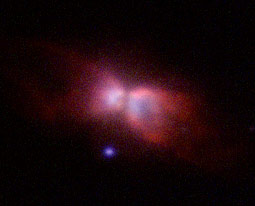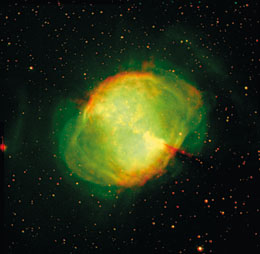Scientific Rationale
The Symposium on Planetary Nebulae is the ideal forum to discuss our current understanding of the origin and evolution of planetary nebulae and PN populations in the framework of the past knowledge acquired in the field, and with special emphasis on the new developments and unexpected recent  results. PNe play a key role in stellar evolution; most stellar matter in the Universe (stars in the approximate range of 1-8 M☉, low- and intermediate-mass stars, or LIMS) go through the AGB and PN phases in their lifetime, thus understanding its working is essential. PNe are key contributors to the chemical enrichment of galaxies, especially for what nitrogen and carbon are concerned.
results. PNe play a key role in stellar evolution; most stellar matter in the Universe (stars in the approximate range of 1-8 M☉, low- and intermediate-mass stars, or LIMS) go through the AGB and PN phases in their lifetime, thus understanding its working is essential. PNe are key contributors to the chemical enrichment of galaxies, especially for what nitrogen and carbon are concerned.
Studies of PNe are crucial for a better understanding of the late stages of stellar evolution. They represent a short-lived transition phase between AGB stars and white dwarfs. Their investigation provides important constraints on a variety of physical processes for which our theoretical understanding is very poor but which play a crucial role in the late stages of stellar evolution, such as mass loss, convection, mixing, and nucleosynthesis.
The study of the abundance gradients in galaxies is one of the most important constraints for models of galaxy formation and evolution, and PNe offer a relatively easy probe class for these tests. PNe are multi-wavelength laboratories for the understanding of atomic, molecular, dust, and plasma processes in different astrophysical environments. The way by which the wonderfully diverse morphologies of PN ![PNG 285.4+01.5 [Pe1-1] PNG 285.4+01.5 [Pe1-1]](../media/Pe1-1.jpg) originate and evolve, including hydrodynamic shaping mechanisms and the role of binarity, magnetic fields and rotation, make them essential to constrain hydrodynamics models and advanced stellar evolutionary calculations. PNe influence the interstellar media of galaxies, enriching them chemically; and they probe the dynamics and mass distributions of galaxies and the intergalactic media of clusters of galaxies.
originate and evolve, including hydrodynamic shaping mechanisms and the role of binarity, magnetic fields and rotation, make them essential to constrain hydrodynamics models and advanced stellar evolutionary calculations. PNe influence the interstellar media of galaxies, enriching them chemically; and they probe the dynamics and mass distributions of galaxies and the intergalactic media of clusters of galaxies.
PNe emit in all spectral regions from X-rays to radio, radiating through a rich variety of physical mechanisms. Observations from have revealed these objects to be extremely complex. Because of their well-defined geometries and their exciting central stars, PN make ideal astrophysical laboratories; their study has led to the elucidation of many different astrophysical processes. They represent the best-studied example of the interactions (radiative, mechanical, and chemical) between stars and the interstellar medium. Lessons learned about PNe can also be extended to the study of other astrophysical objects such as young stellar objects, supernovae, H II regions, and AGNs.
One of the most rapidly advancing fields of PN research is the study of PNe in galaxies beyond the local group. With 8m-class telescopes  and new Multi Object Spectroscopy instrumentation, these can be found in large numbers against the background stars thanks to their strong monochromatic emission. As well as enabling the dynamics of all galaxy classes to be probed, PNe have been successfully used as standard candles to measure the size of the universe, and provide perhaps the best tracers we have of dark matter in galactic halos, and of the intra-cluster medium. At present, the discussion of the workings of the PN luminosity function as a secondary distance indicator for external galaxies is on the forefront and needs to be deepened.
and new Multi Object Spectroscopy instrumentation, these can be found in large numbers against the background stars thanks to their strong monochromatic emission. As well as enabling the dynamics of all galaxy classes to be probed, PNe have been successfully used as standard candles to measure the size of the universe, and provide perhaps the best tracers we have of dark matter in galactic halos, and of the intra-cluster medium. At present, the discussion of the workings of the PN luminosity function as a secondary distance indicator for external galaxies is on the forefront and needs to be deepened.

